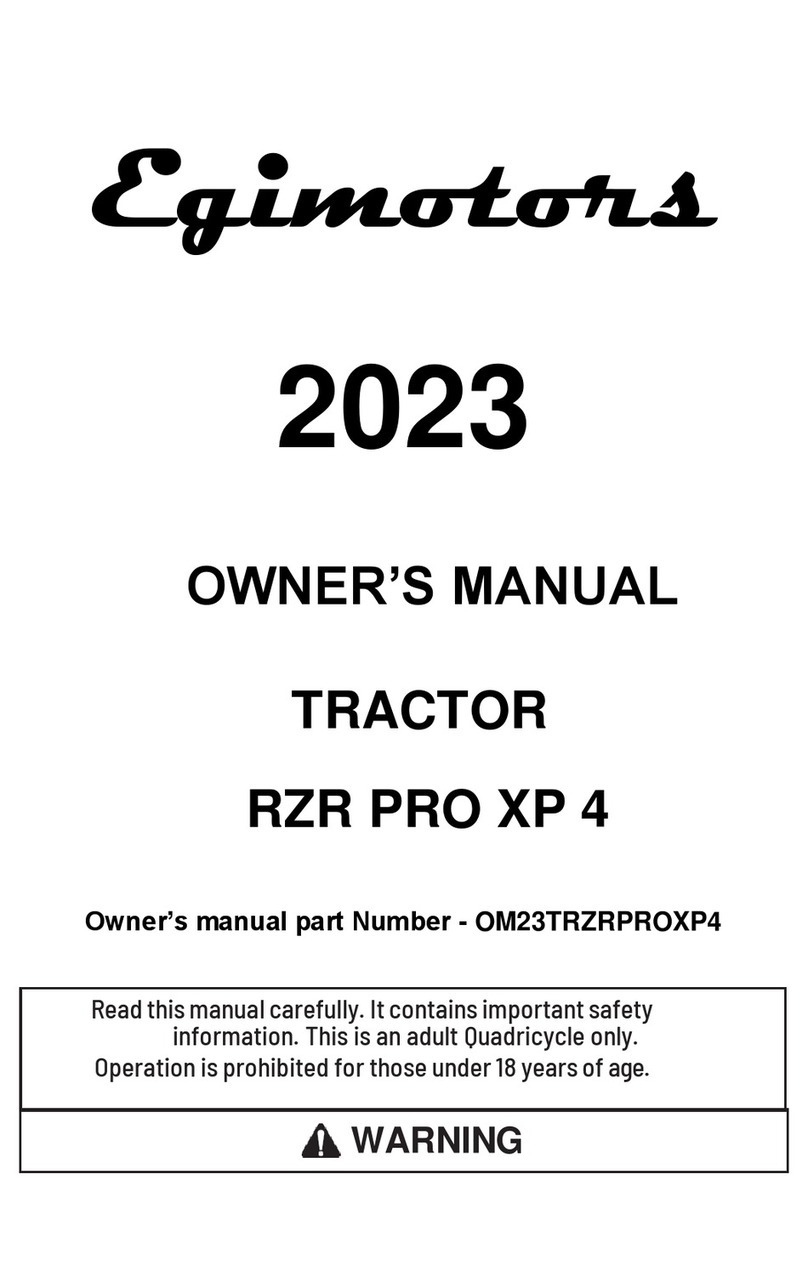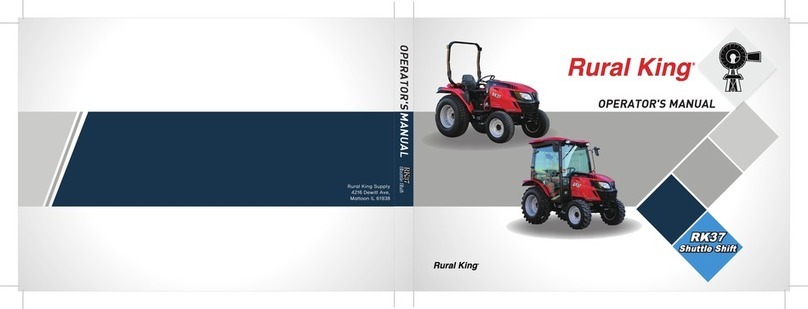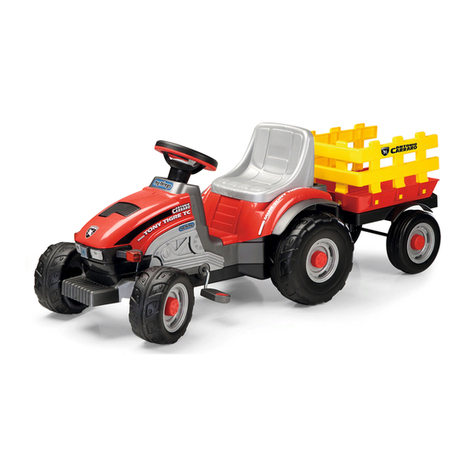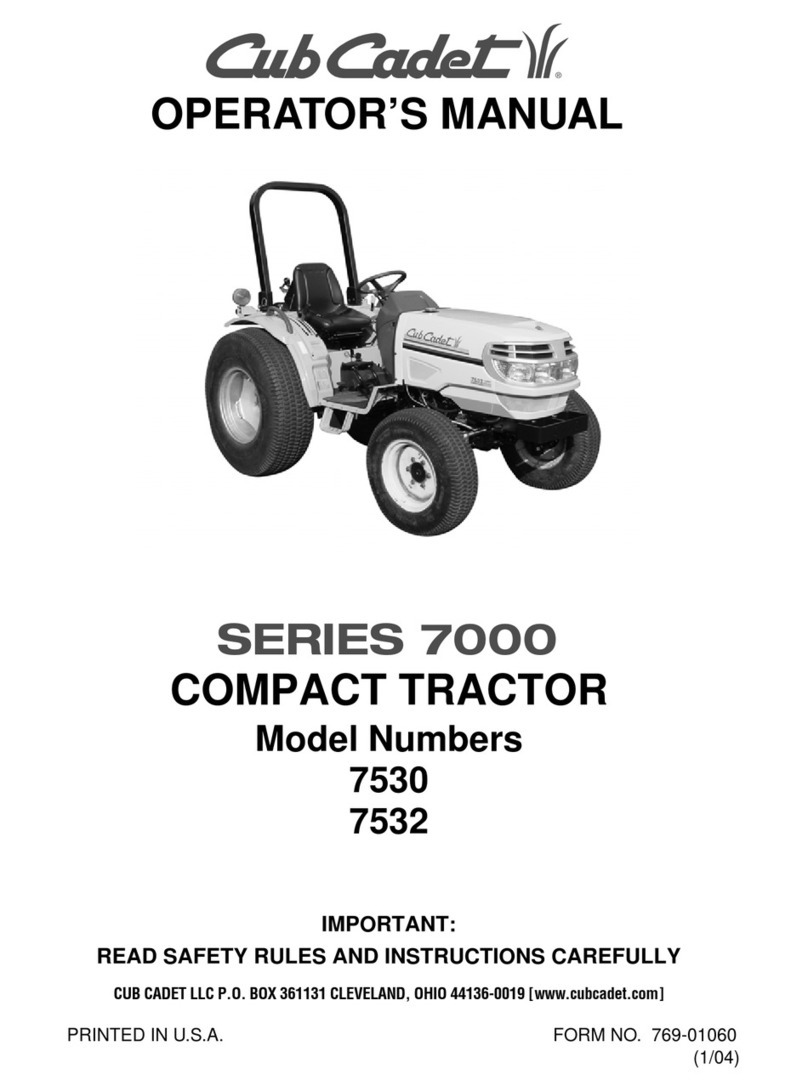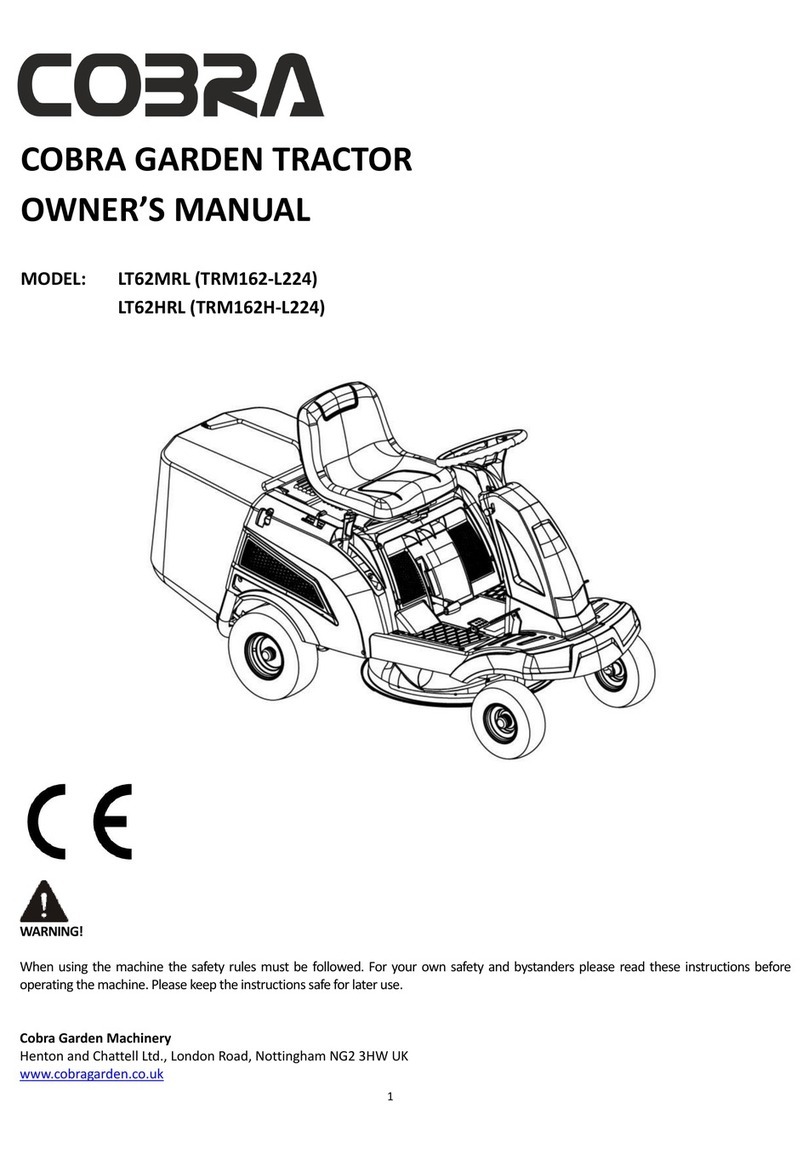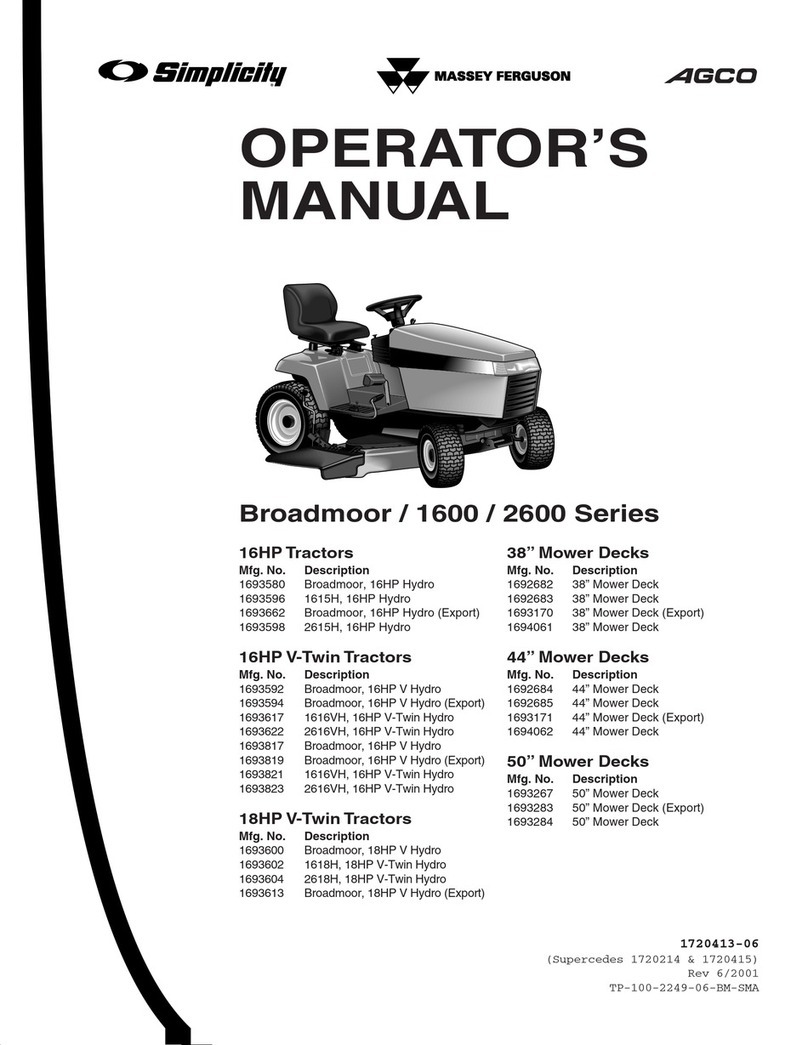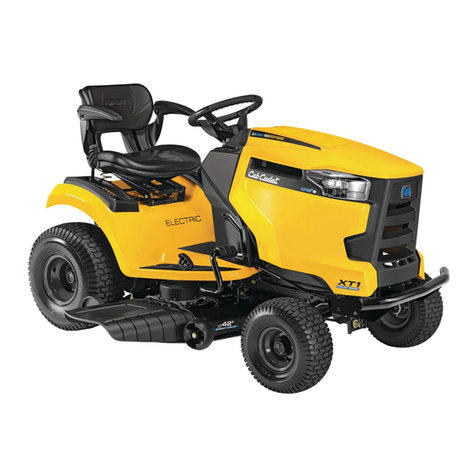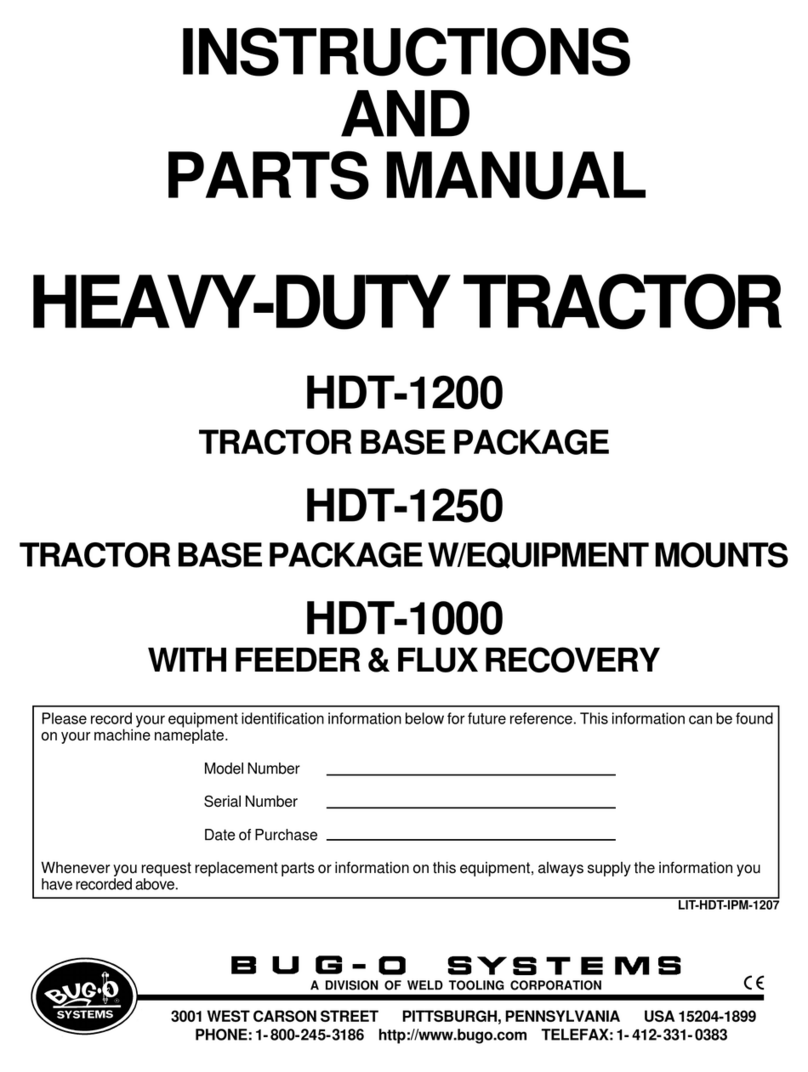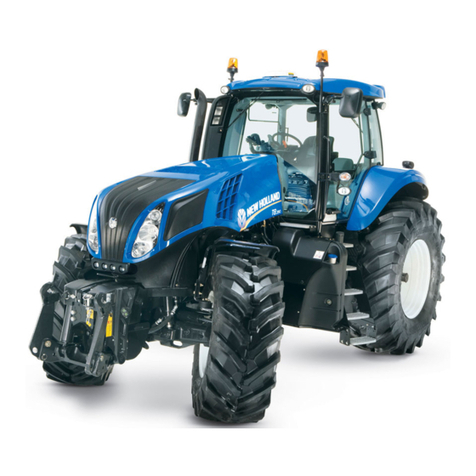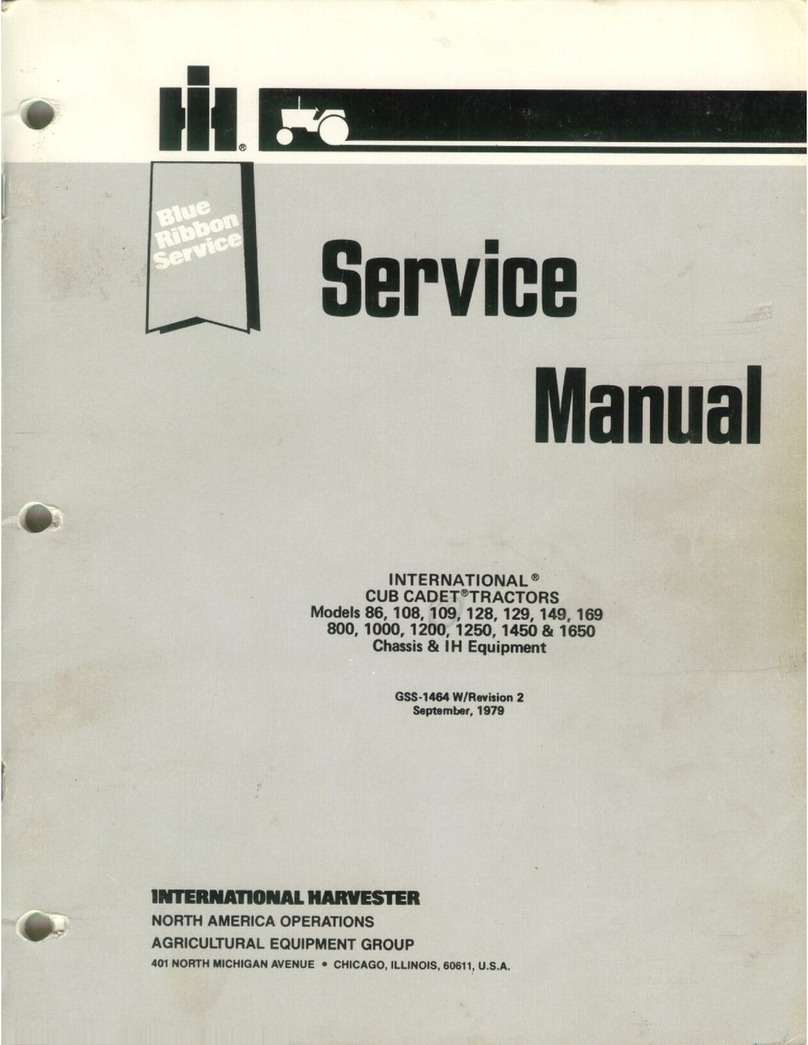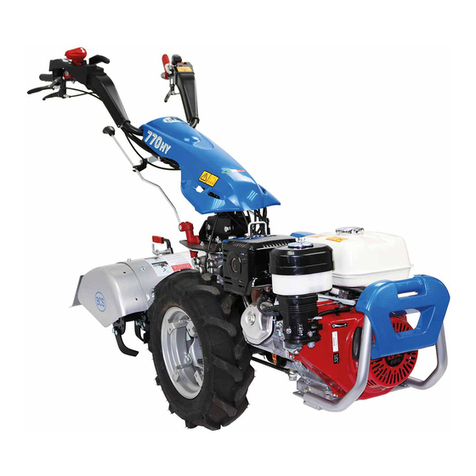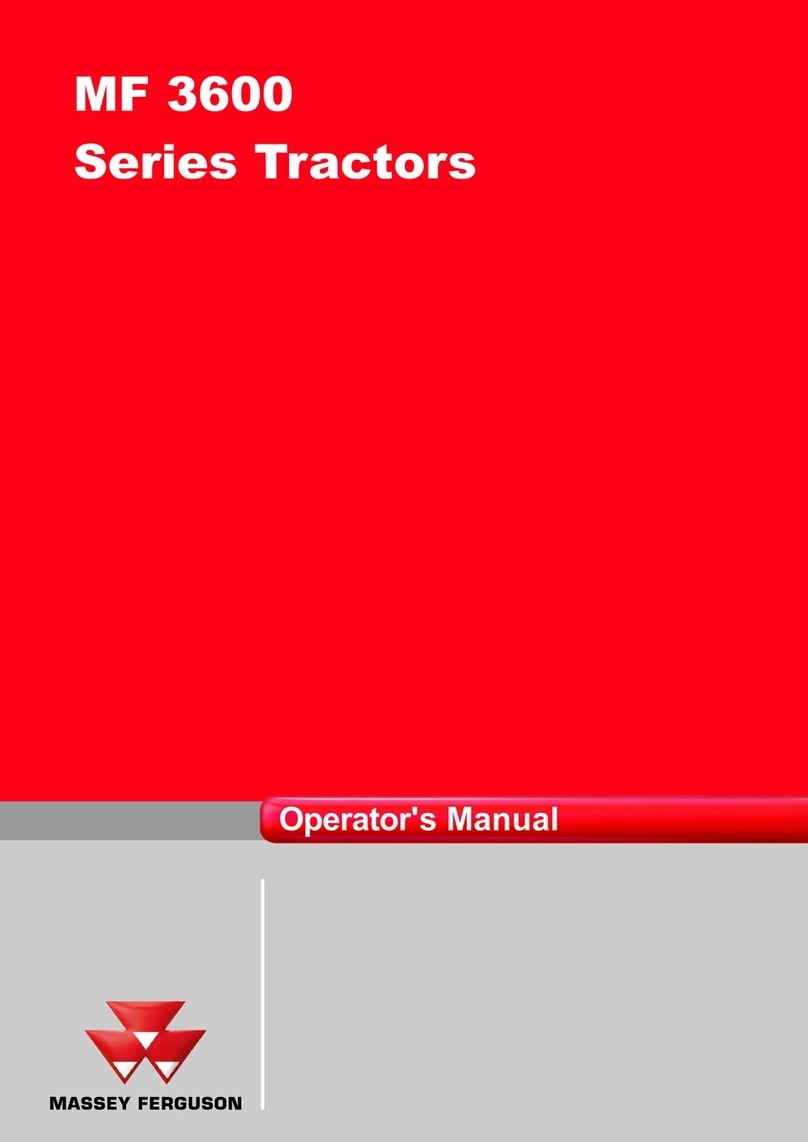Egimotors RZR XP 1000 4S 2023 User manual

Read this manual carefully. It contains important safety
information. This is an adult Tractor only.
Operation is prohibited for those under 18 years of age.
Egimotors
2023
OWNER’S MANUAL
TRACTOR
RZR XP 1000 4S
Owner’s manual part Number - OM23TRZRXP10004S
WARNING


This Owner Manual refers to EGIMOTORS TRACTORS
(To be filled in by your Dealer)
This Owner’s Manual must remain inside your Tractor
(Legal requirement)
A digital/printable copy is available on www.Egimotors .it
Model Type___________________________________________________
Year ________________________________________________________
Code number (spare parts use only) _______________________________
VIN Number__________________________________________________
Engine Serial Number __________________________________________
Personal PIN Security Code:______________________________________
Registration Plate Number ________________________________

TABLE OF CONTENTS
5
Thank you for purchasing an Egimotors Tractor, and welcome to our world-
wide family of enthusiasts.
We have done This manual to inform you on how to use and maintain the
best condition of operation for your Tractor.
If after reading this manual, you still have some questions please do not
hesitate to contact your dealer that will be available to help you.
Be sure to visit us online at www.Egimotors .it for the latest news and for
product and Safety information.
We believe we sets a standard of excellence for all utility and Tractor
manufactured in the world today.
Many years of experience have gone into the engineering, design, and
development of your Tractor, making it the finest machine we’ve ever
produced.
For safe and enjoyable operation of your Tractor, be sure to follow the
instructions and recommendations in this owner’s manual.
Your manual contains instructions for the maintenance of the Tractor and
information about repairs.
Service Manual are available from Dealers, only them can perform major
repair and install accessory.
Your dealer knows your Tractor better than anyone and is interested in your
total satisfaction, he can perform your service needs during and after the
warranty period.

INTRODUCTION
7
INTRODUCTION
IMPORTANT
INFORMATION
WARNING
Failure to follow the warnings contained in this manual can result in severe
injury or death.
This Tractor is not a toy and can be hazardous to operate. This Tractor handles
differently than other Tractor. A collision or rollover can occur quickly, even
during routine maneuvers, if you fail to take proper precautions.
•
Read this owner’s manual. Understand all safety warnings, precautions and
operating procedures before operating the Tractor. Keep this manual with
the Tractor at all times.
•
This Tractor is an ADULT TRACTOR ONLY. You MUST be at least 18
years of age and have a valid driver’s license to operate this Tractor.
•
No person under the age of 12 may ride as a passenger in this Tractor.
•
Never permit a guest to operate this Tractor unless the guest has read this
manual and all product labels.
•
Always keep hands, feet, and all other body parts inside the Tractor at all
times.
•
Always wear the proper clothing when operating or riding in this Tractor. All
riders should wear substantial footwear, long pants, and a close-fitting shirt.
A hard hat or helmet and approved eye protection are recommended when
appropriate for riding or working conditions.
•
Never operate this Tractor under the influence of drugs or alcohol, as these
conditions impair judgement and the operator’s ability to react.
TOOLS FOR SAFE RIDING
To safely operate this Tractor, it is important to become familiar with its features,
controls, and characteristics. Review the Safety Briefings for this Tractor that
apply to you:
•
Operators
•
Riders
•
Owners
•
Trailering the Tractor
•
Maintaining the Tractor
Additionally, read the product safety labels on the Tractor and follow all rules and
regulations concerning the operation of this Tractor in your area.

8
Not all devices are equipped with an NFC reader. Additionally, some devices
require third party applications to access NFC content. For questions regarding
the NFC reader on your device, refer to the device’s user manual.
IMPORTANT
NEAR-FIELD COMMUNICATION (NFC)
(IF EQUIPPED)
Some Egimotors Tractor come equipped with a near-field communication
(NFC) chip. The NFC chip is embedded in the Egimotors emblem located at
the front of the Tractor and seamlessly connects you to a digital platform of
Tractor information and tools. See your dealer for more information.
On models equipped with NFC, place your smartphone directly over the Egimotors
emblem to do the following:
•
View Tractor-specific
information
•
Access your Egimotors Garage
•
Download and view the
owner’s manual
•
View accessory instructions
•
Watch how-to videos
•
Access warranty information
•
Check for service notifications
RIDE COMMAND WITH NFC
Additional NFC features are available when using the Ride Command mobile
app. To access these features, do the following:
1.
Download the Ride Command mobile app from the Apple App Store® or
Google Play® store.
2.
Create or log in to an existing account.
3.
From the Ride Command mobile app home screen, select Add Tractor.
4.
On the Tractor, tap the NFC-enabled badge with the phone to scan the
Tractor.
5.
Confirm information, name your Tractor, and tap add to garage.
SYSTEM
REQUIREMENTS
Refer to device manufacturer’s instructions to verify NFC read capability, and/or
NFC-capable add-ons.

INTRODUCTION
9
TRACTOR
IDENTIFICATION
NUMBERS
Record your Tractor’s identification number q, engine
serial number w, and key number e in the spaces
provided. Remove the spare key and store it in a safe
place. An ignition key can be duplicated only by
ordering a EGIMOTORS key blank (using your key
number) and mating it with one of your existing keys.
The ignition switch must be replaced if all keys are
lost.

13
SAFETY
OWNER REQUIREMENTS
Improper use, maintenance, or modification of this Tractor can lead to
serious injury or death.
Require proper use of your Tractor. Do not allow
anyone to operate your Tractor or ride as a passenger
unless they are properly instructed and you are sure
they are willing to ride responsibly. To prevent
unauthorized use, always remove the ignition key
when the Tractor is not in use.
Any modifications or installation of non-POLARIS-approved accessories
could increase the risk of injury. While you may find aftermarket products
similar in design and quality to EGIMOTORS accessories, recognize that some
aftermarket accessories or modifications are not suitable because of potential
safety hazards to you or others. It is never appropriate to install any additional
seating.
Check with the manufacturer to determine any potential effect of a modification
or accessory on the safe use of your Tractor. You are responsible for injuries
related to modifications to the Tractor. Modifications or accessories may:
•
Damage machine components - especially modifications that increase speed
or power.
•
Make the Tractor less stable at higher speeds.
•
Add weight, reducing the amount of cargo and total weight you can carry, and
raise the Tractor’s center of gravity.
•
Overload the Tractor’s electrical system capacity. Blowing a fuse may cause a
loss of lights or engine power.
•
Reduce the effectiveness of occupant protection systems, including the
seatbelts and the Rollover Protective Structure (ROPS).
•
Make it illegal to own or operate your Tractor. POLARIS-authorized spark
arresters, mufflers, and emissions control components are mandatory for
ownership or operation in many areas.
•
Void your warranty.
The Tractor ROPS, when used with the seat belts and doors, provides a
structure to help protect occupants. The structure will not protect occupants
in all rollovers or accidents.

SAFETY
14
DRIVER
AND
PASSENGER
QUALIFICATIONS
Make sure operators are 18 or older with a valid
driver’s license. Just because a teenager has a
license does not mean that they will make good
judgments about driving and avoid risk taking.
EGIMOTORS recommends that you supervise younger
drivers. Set rules and put limits on how, when, and where
they are allowed to use this Tractor. For example, young
drivers may need to have an adult in the Tractor with them
and not be allowed to drive with their friends in the Tractor.
Make sure all riders fit the Tractor. Be sure that the driver and all passengers
are able to:
•
sit with their backs against their seat,
•
adjust the seat belt to fit properly,
•
have both feet flat on the floor, and
•
have both hands on the steering wheel or on a passenger hand hold.
Do not allow children who need child safety seats or booster seats to ride
in the Tractor. The Tractor is not designed to restrain automotive child safety
seats.
You are responsible for your passengers. Be sure passengers are seated
properly, belted, holding the passenger hand hold, and ready to brace.
Unrestrained riders can fall out or be thrown around and from a moving Tractor.
Every person must be properly seated and belted in their own seat. Two
people should never be belted into a single seat belt. People belted together can
crash into one another in a collision and be seriously injured. Never carry
passengers in the cargo bed as they could be thrown against or out of the
Tractor or come into contact with moving parts.
Do not let people drive or ride after using alcohol or drugs.
18

15
PREPARE TRACTOR FOR THE RIDE
Before starting off, always perform the Pre-Ride
Inspection. Failure to inspect and verify that the Tractor is
in safe operating condition increases the risk of an
accident, which can lead to serious injury or death.
ITEM
REMARK
Brake Fluid
Ensure proper level and
condition
Front and rear
suspension
Inspect, lubricate if
necessary
Steering
Ensure free operation
Tires
Inspect condition and
pressure
Wheels/Lug
Nuts
Inspect, ensure
fastener tightness
Fuel and oil
Ensure proper levels
and condition
Coolant
Ensure proper level and
condition
Indicator
lights/switches
Ensure proper
operation
Air Filter
Inspect, replace as
needed
Engine intake pre-filter
Inspect, clean
PVT
intake
pre-filter
Inspect, clean
Headlights
Check operation
Brake lights/taillights
Check operation
Seat Latches
Push down on both seat
backs to ensure the
latches are secure

SAFETY
16
ITEM
REMARK
Seat Belts
Check length of belt for
damage, check latches
for proper operation
Exhaust
Inspect spark arrester
and clean if needed.
Tractor
Debris
Remove grass, leaves,
and other flammable
material or debris,
especially near the
exhaust system.
Passenger Hand Hold
Always adjust the hand
hold to a comfortable
position for your
passenger before
operating. Make sure
the clasps are fully
locked after making
adjustments.
Lock adjustable
steering wheel
Do not adjust the
steering wheel while the
Tractor is moving.

17
Improper tire maintenance can lead to loss of control and an accident, which
could result in serious injury or death. To reduce your risk of injury:
•
Maintain EGIMOTORS recommended tire pressure. Check pressure
before operating. Even if your Tractor has only been driven a short distance,
the tire pressure readings can become higher.
•
Make sure tire pressures match the specifications listed in the table below.
•
Only use the size and type of tires specified for this Tractor.
•
Do not operate your Tractor with worn or damaged tires.
•
Always follow your tire manufacturer’s instructions for maintenance.

SAFETY
18
PREPARE YOURSELF, PASSENGERS, AND
CARGO FOR THE RIDE
Wear an approved helmet. Riding in this Tractor without wearing an approved
helmet increases the risk of serious injury. For example, a helmet reduces your
risk of injury from head strikes with the Tractor or other objects even if there is no
crash.
Approved helmets in the USA and Canada bear a U.S.
Department of Transportation (DOT) label. Approved
helmets in Europe, Asia, and Oceania bear the ECE
22.05 label. The ECE mark consists of a circle
surrounding the letter E, followed by the distinguishing
number of the country which has granted approval.
The approval number and serial number will also be
displayed on the label.
Use shatterproof goggles or a shatterproof helmet face shield. Such
protective eyewear may reduce the risk of foreign material getting in your eyes
and help prevent loss of vision.
EGIMOTORS recommends wearing approved
Personal Protective Equipment (PPE) that have
markings indicating they are designed to standards
such as:
•
CE
Additional protective clothing and gear that may be appropriate for your
riding conditions includes:
•
Always wear shoes when operating. Consider wearing sturdy over-the-ankle
boots suitable for the terrain you will be riding in.
•
Full-finger gloves can protect against wind, sun, cold, and objects. Choose
gloves that fit snugly and allow fingers to move freely and grip on the steering
wheel or hand holds.
•
Consider long sleeves and long pants to help protect arms and legs.
•
Long-term exposure to wind and engine noise can cause permanent hearing
loss. Properly worn hearing protective devices such as earplugs can help
prevent hearing loss. Check local laws or the rules of the riding area you are
in before wearing hearing protection to make sure its use is permitted.

19
Always stay completely inside the Tractor and hold the steering wheel or
hand holds. Body parts outside of the Tractor can be struck by passing objects
or crushed during a rollover. Do not put any part of your body outside of the
Tractor for any reason. Do not hold onto the ROPS frame or put any part of your
body on the door.
Riding in this Tractor without closed and latched cab doors increases the risk of
serious injury or death in the event of an accident or rollover. Always make sure
all cab doors are closed and latched while riding in this Tractor.
Be sure riders pay attention and plan ahead. If you think or feel the Tractor
may tip or roll, reduce your risk of injury:
•
Keep a firm grip on the steering wheel or hand holds and brace yourself.
•
Do not put any part of your body outside of the Tractor for any reason.
This Tractor is not designed to carry unrestrained pets. An unrestrained pet
can be thrown about and injure riders, even during normal operation. When
transporting pets, use a pet crate suitable for off-road use that is secured to the
Tractor.
Fuels such as gasoline can be extremely flammable. To reduce the risk of
serious injury or death, never carry fuel or other flammable liquids on this
Tractor. Rollovers, crashes, rough riding, or changes in elevation or temperature
may lead to fuel spilling or vapor release from portable containers. Hot Tractor
parts can cause fires, even after the engine has been turned off.
Never exceed Tractor weight capacities. Overloading the Tractor or carrying
cargo improperly will cause changes in stability and handling, which could cause
loss of control or an accident. See the Specifications chapter for weight
capacities.
Secure cargo in the cargo box as far forward, centered and as low as
possible. When cargo cannot be positioned and secured in this way, operate
with extra caution. Unsecured cargo can strike and injure riders, affect Tractor
handling, and result in loss of control.
The weight of riders and cargo changes Tractor braking, handling, and
stability. To avoid loss of control, turn gradually, operate at slower speeds, and
avoid rougher or steeper terrain.

SAFETY
20
DRIVING
GUIDELINES
Drive responsibly. This Tractor is not a toy and
can be hazardous to operate. This Tractor has
higher ground clearance and other features to
handle rugged terrain. It can be overturned in
situations where some other Tractor may not.
Abrupt maneuvers or aggressive driving, even on
flat, open areas, can cause loss of control,
rollovers, severe injury or death. To avoid loss of
control and rollovers:
•
Avoid abrupt maneuvers, sideways sliding, skidding, or fishtailing, and never
do donuts.
•
Slow down before entering turn.
•
Avoid hard acceleration when turning, even from a stop.
High speed off-road operation
Driving off-road Tractor to test the limits of your skills or abilities can be very
dangerous to you, passengers, and bystanders. Basic skills for driving a car,
ATV, or other off-road Tractor do not equip drivers to safely attempt high speed
off-road operation. Develop your skill gradually through training, practice, and
experience with the various driving modes of this Tractor and the terrain in which
you are operating. Always do a low speed reconnaissance run (prerun) to
become aware of anything you may encounter.
High speed off-road operation can lead to loss of control, crashes, or hard
landings that can seriously injure occupants (even without rolling the Tractor or
damaging it).
If you plan on using the Tractor for high speed, off-road competition, additional
safety equipment may be necessary. Check the rules that apply to your
competition.
Do not go over jumps — going airborne can lead to serious injury or death.
Going airborne can cause loss of control, rollovers, or crashing into the ground
and may damage the Tractor. Even without crashing, landings can be hard
enough to cause any Tractor suspension to fully compress (e.g., bottom out).
Serious injuries, including spinal injuries, can occur even if riders are properly
harnessed, wearing helmets and the Tractor is not damaged and remains
upright.
You may encounter slopes, "jumps", or other terrain features that could send the
Tractor airborne, depending on your speed. These may be defectively designed,
poorly maintained, or not suitable for this Tractor. Slow down, use extra care,
and avoid going airborne. Never take this Tractor over jumps.

21
Watching someone else go over a jump or go airborne does not mean you can
safely do so. Egimotors cannot determine whether any jump you may
encounter is appropriate for this Tractor. Any jump, even a small one, could be
poorly maintained, designed, or not suitable for this Tractor and may cause
serious injury or death.
Plan for hills, rough terrain, ruts, and other changes in traction and terrain.
Proceed slowly and with extra care on unfamiliar terrain. Avoid paved surfaces.
Sudden changes in terrain such as holes, depressions, banks, softer or harder
ground, or other irregularities may cause loss of control or rollover. Give yourself
time to react to rocks, bumps, or holes that may be hard to see. Operating in
deep snow or tall grass may make it harder to see obstacles.
If you cannot go around an obstacle, such as a fallen tree or a ditch, stop the
Tractor in a safe place. Get out to inspect the area thoroughly. Look from both
your approach side and exit side. If you are reasonably confident you can
continue safely, choose the path that will allow you to go straight over the
obstacle to minimize the Tractor tipping sideways. Go only fast enough to
maintain your momentum, but still give yourself plenty of time to react to
changes in conditions. If there is any question about your ability to maneuver
safely over the obstacle, you should turn around if the ground is flat and you
have the room, or back up until you find a less difficult path.
Abrupt application of the accelerator pedal can cause the tires to lose traction,
reducing control of the Tractor and increasing the possibility of an accident,
especially while on sloped terrain or while crossing obstacles such as rocks or
logs.

SAFETY
22
TRACTOR
MODELS
ONLY
This Tractor is approved for on-road use, limited to local road and NOT HIGHWAYS
Improperly operating on hills can cause loss of control, rollover, or
accident, which can lead to serious injury or death. Use extra care when
operating on hills. Plan for rough terrain, ruts, and other changes in traction and
terrain.
Driving up hills
Check the terrain before ascending a hill and make sure it is not too slippery or
loose. Engage all-wheel drive for hills. Drive straight uphill, keeping speed and
throttle steady. Avoid steep hills which can cause the Tractor to overturn.
Recovering from stalling on a hill
If the Tractor loses forward speed, apply the brakes gradually and stop. Do not
attempt to turn the Tractor around. Instead, shift to reverse and allow the Tractor
to slowly roll straight downhill. Apply light brake pressure to control speed.
Overtopping a hill
Slow down when you reach the crest of a hill. Never blindly go over the crest of a
hill or a drop off at high speed. An obstacle, a sharp drop, or another Tractor or
person could be on the other side of the hill.
Driving down hills
Check the terrain before descending a hill and make sure it is not too slippery or
loose. Engage all-wheel drive and proceed slowly, applying the brakes lightly.
Never descend a hill with the transmission in neutral or if the engine is turned off.
Avoid side hilling (riding across slopes)
If unavoidable, proceed slowly and with extra caution. Avoid obstacles and
changes in terrain that could cause the Tractor to tip or slide. If it feels like the
Tractor begins to tip or slide, immediately turn downhill.

23
Riding near wooded areas or brush
Use extra caution when operating near trees, particularly when operating on
narrow trails. Tree branches or brush can be driven into the cab striking or
stabbing occupants.
Riding in snow
Always keep the brake and accelerator pedals free of snow and ice. Apply the
brakes frequently to prevent ice or snow accumulation on the brake pads which
can reduce brake performance.
Riding on ice
Never operate the Tractor on a frozen body of water unless you have verified
that the ice can support the weight of the Tractor. Severe injury or death can
result if the Tractor falls through the ice.
Riding in water / Falling into water
Operating through deep or fast-flowing water can cause loss of traction, loss of
control, overturning, or being swept away in water. You can be seriously injured
or killed from entrapment and drowning. Never operate the Tractor in
fast-flowing water or in water that exceeds the floor level of the Tractor. Avoid
sharp drop-offs and large rocks. Choose a path that provides an entrance and
exit point with gradual inclines. Wet brakes may have reduced stopping ability.
After leaving water, test the brakes. Apply them lightly several times while
driving slowly. The friction will help dry out the pads.
Riding on sand dunes
Use extra caution when operating on or near dunes. Be alert for changes in
terrain. Never blindly go over the crest of a hill or a drop-off at high speed. An
obstacle, a sharp drop, or another Tractor or a person could be on the other side
of the hill.
Riding in low-visibility conditions
Use extra caution and drive slowly in conditions of reduced visibility such as fog,
rain, and darkness.
Plan ahead to avoid the need for evasive maneuvers, such as swerving.
Hitting an obstacle — including wildlife — you are not ready for can be
dangerous. Choosing to swerve instead can be even more dangerous because
it can lead to loss of control, rollover, or collisions.
When operating in areas with possibility of wildlife appearing in your path, plan
ahead to avoid swerving for animals if doing so could result in collisions or
rollovers. Go slowly or avoid driving during seasons or times of day when
animals such as deer are more likely to cross your path without warning.

SAFETY
24
Avoid Collisions With Other Tractor
When following another Tractor or operating in the same area as others, keep a
safe distance to avoid collisions. Allow extra space when sight distances are
limited by dust, snow, curves, hills, or other conditions. Plan ahead to avoid
having to swerve or leave the trail to avoid a collision.
On trails, be prepared to make space for other Tractor to pass. If you need to
stop on a trail, move your Tractor to the edge of the path to allow others to pass
safely.
Correct a skid by turning the steering wheel in the direction of the skid.
Never apply the brakes during a skid.
If the Tractor begins to slide downhill or you feel it may tip, turn downhill
immediately and stop. Maneuver slowly and carefully until you can drive straight
downhill.
Do not continue driving if your Tractor may be damaged or if you were in a
crash or rollover.
Operating the Tractor while damaged or after a crash or rollover can cause loss
of control, rollover, or accident, which can lead to serious injury or death. If you
cannot safely transport the Tractor on your own, contact a recovery and towing
service.
After any crash, rollover, or other accident, have a dealer inspect the Tractor for
possible damage, including seat belts, ROPS, brakes, suspension, and steering
systems.
Be prepared in case your Tractor becomes damaged or disabled, especially in
remote areas. Consider in advance how to get help and stay safe until it arrives
whenever you ride.
There is a recovery tow loop at the front and back of the Tractor to attach a
winch or strap.
Use these loops to recover this Tractor if it is stuck, to pull it onto a tow truck,
trailer, or to use this Tractor to recover another Tractor. These loops are for
emergency recovery only and are not for towing Tractor to another location.
Improper recovery may lead to loss of control or Tractor damage. Only attach
straps to specified locations. Do not attach to any other point on the Tractor.
Only recover a Tractor of equal or lesser size and weight. When recovering a
disabled Tractor, place the disabled Tractor’s transmission in neutral. Do not
move a disabled Tractor faster than 16 km/h.

25
Operating, Idling, Or Parking Near Combustible Materials
Engine, exhaust, and other Tractor components can be very hot during and after
use. Do not idle or park the Tractor over anything that could contact the exhaust
system and catch on fire, such as tall grass, weeds, brush, leaves, debris, or
other tall ground cover. Do not let mud, grass, or other debris accumulate on the
engine or exhaust system. Inspect and remove as needed.
Tractor rollaway can cause serious injury or death. This Tractor can roll
whenever the gear selector is not in the PARK (P) position. Always shift to PARK
(P) when stopping the engine or leaving the Tractor. When leaving the Tractor
on an incline is unavoidable, use extra care. If leaving the Tractor unattended,
block the rear wheels on the downhill side and keep children, pets, and others
away from the gear selector.
Before shifting into reverse, use extra care to make sure the area is clear
of people or obstacles. When it’s safe to proceed, back slowly.
After operation, inspect the Tractor for damage and debris to make sure the
Tractor can be safely stored and operated again. Some things to inspect include:
•
Debris that could catch fire, such as mud/grass near the engine or exhaust
system
•
Damage to the suspension, steering, or any other part of the Tractor
•
Tire condition, such as tread and sidewall damage
•
Shock absorber assembly condition
Be sure to have any issues checked and problems fixed before operating again.
All engine exhaust contains carbon monoxide, a deadly gas. Breathing
carbon monoxide can cause headaches, dizziness, drowsiness, nausea,
confusion, and eventually death. Carbon monoxide is a colorless, odorless,
tasteless gas which may be present even if you do not see or smell any engine
exhaust. Deadly levels of carbon monoxide can collect rapidly, and you can
quickly be overcome and unable to save yourself. Also, deadly levels of carbon
monoxide can linger for hours or days in enclosed or poorly ventilated areas. If
you experience any symptoms of carbon monoxide poisoning, leave the area
immediately, get fresh air, and SEEK MEDICAL TREATMENT.
•
Do not run engine indoors. Even if you try to ventilate engine exhaust with
fans or open windows and doors, carbon monoxide can rapidly reach
dangerous levels.
•
Do not run engine in poorly ventilated or partially enclosed areas such as
barns, garages, or carports. If you start a Tractor in one of these, drive it out
and close the door as soon as possible. If you drive it into one of these, turn it
off as soon as possible.
•
Do not run engine outdoors where engine exhaust can be drawn into a
building through openings such as windows and doors.
The above list of hazards and overturning risk is not exhaustive.
Table of contents
Other Egimotors Tractor manuals
